Electricity sector in Russia
This article needs to be updated. (April 2014) |


Russia is the fourth largest generator and consumer of electricity in the world. Its 440 power stations have a combined installed generation capacity of 220 GW.[1]
Russia has a single synchronous electrical grid encompassing much of the country. The Russian electric grid links over 3,200,000 kilometres (2,000,000 mi) of power lines, 150,000 kilometres (93,000 mi) of which are high voltage cables over 220 kV. Electricity generation is based largely on gas (46%), coal (18%), hydro (18%), and nuclear (17%) power. 60% of thermal generation (gas and coal) is from combined heat and power plants. Russia operates 31 nuclear power reactors in 10 locations, with an installed capacity of 21 GW.[1]
Despite considerable geothermal and wind resources, this accounts for less than one percent.[1]
History
[edit]Tsarist period
[edit]The electric power industry first developed in Russia under the Tsarist regime. The industry was highly regulated particularly by the Ministry of Finance, the Ministry of Trade and Industry and the Ministry of Internal Affairs. This led to considerable delay as electrification was not made a priority in the process of industrialisation.[2]: 11–2
Provisional Government (1917)
[edit]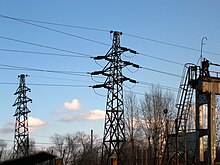
The eight months of the provisional government laid the groundwork for a state-owned approach to electrification as part of their move towards a centrally planned economy. They set up the Central Economic Committee.
Soviet electrification
[edit]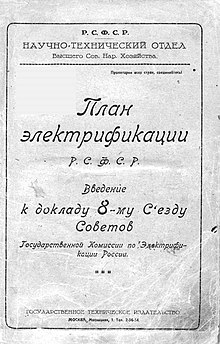
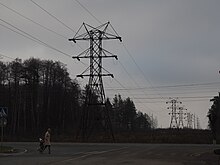
Electrification was a key part of the Bolshevik political programme:
Communism is Soviet government plus the electrification of the whole country.
This led to the creation of the GOELRO plan (Russian: план ГОЭЛРО) as the first-ever Soviet plan for national economic recovery and development. It was the prototype for subsequent Five-Year Plans drafted by Gosplan. GOELRO is the transliteration of the Russian abbreviation for "State Commission for Electrification of Russia" (Государственная комиссия по электрификации России).
After World War II
[edit]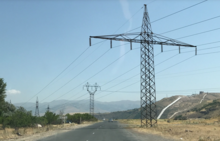
The second world war stopped the electrification programs in the western Soviet Union and left severe damages on generating and transmission systems. After 1945, the soviets took generators, transformers and even electricity pylons from occupied germany. Even whole power plants (e.g. Trattendorf power station) were dismantled and transported into the soviet union.
In 1954 the first nuclear power plant was commissioned in Obninsk.
In 1985 a 1150-kV ultra-high-voltage power line was commissioned, the first power line operated with more than 1000 kV.
Post Soviet development
[edit]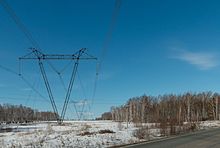
After the collapse of the Soviet Union, Unified Energy System of Russia RAO UES was founded as state-owned (50%) company. From 1992 to 2008 it was the largest electric power holding company. Four energy companies - Novosibirskenergo, Tatenergo, Irkutskenergo and Bashenergo - managed to avoid incorporation into RAO UES.[4]
Privatization and reform
[edit]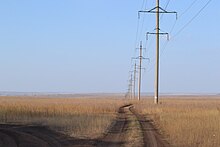
In 2002, the Russian government began reforming the power sector. The main goal was and remains upgrading the aging and outdated heating and electricity infrastructure. The restructuring involved the separation and privatization of the generation, transmission and sales companies. The grids were brought under regulatory supervision.[1]
Power generation was divided up into seven wholesale generating companies (OGK) – including RusHydro, 14 territorial generating companies (TGK), independents and state-owned entities. OGKs contain power plants and specialize mainly in electric power generation. TGKs contain predominantly combined heat and power plants (CHPs).[1]
The gradual liberalization of the wholesale electricity market, completed in January 2011, now allows producers to charge market prices. The transmission grid remains mostly under state control.[1]
As a result of the reorganization, Inter RAO UES became a major generating company in Russia in the field of export and import of electric power. The total installed capacity of the power plants owned or managed by the company is around 18,000 MW. The company's main types of activities are generation of electric and thermal power, sales of electric and thermal power to consumers and export and import of electric power.[1]
Post-reform developments
[edit]Price increase followed the reform process, 3-4 times the margin set by regulatory authorities.[5] In November 2011, then prime minister Vladimir Putin tasked the Ministry for Economic Development (Russia), the Ministry of Energy (Russia) and the 'Federal Tariffs Service' to draft a government resolution restricting the profitability of electric utilities. This "restricted the ability of electric utilities to make money from providing services other than supplying electricity"[5]
As of 2013, Russia had no wholesale electricity market. The Ministry for Energy of Russia, concerned with price increases envisions a wholesale market under bi-lateral contracts between consumers and specific power plants. Inter RAO and Gazprom Energy Holding were lobbying for a different one.[5]
Equipment producers
[edit]The Saint Petersburg-based Russian energy systems machine-building company Power Machines is the leading Russian equipment producer, with a share of over 50%.[1] It unites production, supply, construction, maintenance and modernization of equipment for thermal, nuclear, hydraulic and gas turbine power plants.
As of 2012, the following big international energy equipment holdings were well established and have joint ventures or their own production facilities in Russia: General Electric, Siemens, Alstom, ABB, Skoda Power, Mitsubishi Heavy Industries, Ansaldo Energia, and Areva.[1]
Power companies
[edit]Territorial generating companies
[edit]- TGK-1 - North-West (Leningrad, Murmansk Oblasts and Karelia);
- TGK-2 - north of Central Russia, Vologda and Arkhangelsk Oblasts;
- Mosenergo (TGK-3) - Moscow and Moscow Oblast;
- Quadra (TGK-4) - Black Earth and southern regions of Central Russia (12 Oblasts in all);
- T Plus Group:
- Lukoil-Ecoenergo (TGK-8) - Southern Federal District;
- Fortum (TGK-10) - Urals Federal District (except for Sverdlovsk Oblast);
- TGK-11 - Omsk and Tomsk Oblasts;
- Siberian Generation Company:
- Kuzbassenergo (TGK-12) - Kemerovo Oblast and Altai Krai;
- Yenisei Territorial Generation Company (TGK-13) - Krasnoyarsk Krai, Khakassia and Tyva;
- TGK-14 - Buryatia and the Trans-Baikal Krai.
Wholesale generating and other companies
[edit]- Inter RAO
- OGK-2
- OGK-6 - merged into OGK-2 in 2010
- Unipro (OGK-4)
- Enel Russia (OGK-5)
- Irkutskenergo - independent vertically integrated company, it owns the production and distribution facilities supplying the Irkutsk region.[6]
- RusHydro - excluded from the 2003 reform law, as it is considered a strategic asset.[7]
- Rosenergoatom - state-owned company controlling all nuclear power generation assets.[8]
Transmission and distribution companies
[edit]Supply companies
[edit]Largest supply companies:[9]
- OJSC First Supply Company
- OJSC Saint Petersburg Supply Company
- OJSC Samaraenergo
- OJSC EK Vostok
Isolated energy systems
[edit]Some parts of the country have limited connections to the Russian unified energy system, reducing the likelihood that new companies will enter the energy supply market by importing energy from neighboring energy systems. Those areas, defined as "non-price" zones, include Kaliningrad Oblast, the Komi Republic, Arkhangelsk Oblast, the south of the Sakha Republic, Primorsk Krai, Khabarovsk Krai, Amur Oblast, and the Jewish Autonomous Oblast.[8]
Additionally, some parts of Russia are completely isolated from the unified energy system, including Kamchatka, Magadan Oblast, Sakhalin Oblast, Chukotka and Taimyr Autonomous Okrug, the western and central parts of the Sakha Republic, as well as many remote settlements across the country.[8] Energy prices in "non-price" and isolated regions are exempt from liberalization and remain regulated.[8]
Consumption
[edit]| Russia | World | Russia % | |
|---|---|---|---|
| 1990 | 827 | 9,708 | 8.5% |
| 1995 | 618 | 10,859 | 5.7% |
| 2000 | 609 | 12,665 | 4.8% |
| 2004 | 646 | 14,415 | 4.4% |
| 2005 | 650 | 15,064 | 4.3% |
| 2006 | 682 | 15,712 | 4.3% |
| 2007 | 701 | 16,487 | 4.3% |
| 2008 | 726 | 16,819 | 4.3% |
| Note: Gross use of electricity 2008: Russia 1,038 TWh, the world 20,181 TWh | |||
In 2008 the end use of electricity was 4.3% (726 TWh) of the world total (16,819 TWh).[10] In 2008 the gross production of electricity was 5.1% (1,038 TWh) of the world total (20,181 TWh).[11]
Mode of production
[edit]- Natural gas: 521,788 GWh (47.9%)
- Nuclear: 196,614 GWh (18.1%)
- Hydro: 186,640 GWh (17.1%)
- Coal: 171,443 GWh (15.7%)
- Oil: 10,968 GWh (1.0%)
- Solar: 462 GWh (0.0%)
- Geothermal: 446 GWh (0.0%)
- Wind: 146 GWh (0.0%)
- Waste: 32 GWh (0.0%)
| Production | Export | Gas | Coal/Peat | Nuclear | Hydro | |
|---|---|---|---|---|---|---|
| 2004 | 930 | 20 | 421 | 161 | 145 | 176 |
| 2008 | 1,038 | 18 | 495 | 197 | 163 | 167 |
| 2008 | 47.7% | 19% | 15.7% | 16.1% | ||
| Note: The end use (2008) Russia 726 TWh. | ||||||
According to the IEA the Russian gross production of electricity was 1,038 TWh in 2008 and 930 TWh in 2004 giving the 4th top position among the world producers in 2008. Top ten countries produced 67% of electricity in 2008. The top producers were: 1) United States 21.5% 2) China 17.1% 3) Japan 5.3% 4) Russia 5.1% 5) India 4.1% 6) Canada 3.2% 7) Germany 3.1% 8) France 2.8% 9) Brazil 2.3% and 10) South Korea 2.2%. The rest of the world produced 33%.[11][13]
Gas
[edit]The share of natural gas fuelled electricity was 48% of the gross electricity production in 2008 in Russia (495 TWh / 1,038 TWh.[11]
Coal and peat
[edit]The share of coal and peat electricity was 19% of the gross electricity production in 2008 in Russia (187 TWh / 1,038 TWh).[11]
Nuclear power
[edit]
In 2008 Russian federation was the 4th country by nuclear electricity production with 163 TWh (6% of the world total). According to the IEA 15.7% of Russian domestic electricity was generated by nuclear power in 2008.[11]
In 2009 Russia had in total 31 nuclear reactors[14] and installed capacity in 2008 23 GW.[11]
Nuclear reactor construction and export
[edit]In 2006 Russia had exported nuclear reactors to Armenia, Bulgaria, Czech Republic, Finland, Hungary, India, Iran, Lithuania, Slovak Republic and Ukraine. In Russia, the average construction time was in 1) 1965-1976 57 months and 2) 1977-1993 72–89 months, but the four plants that have been completed since then have taken around 180 months (15 years), due to increased opposition following the Chernobyl accident and the political changes after 1992.[15]
Hydropower
[edit]As of 2008[update] hydroelectric power plants generated 167 TWh from a total capacity of 47 GW. Russia is the 5th-largest producer of electricity from hydropower in the world, accounting for 5.1% of the world's hydroelectric generation. The use of other renewable sources for electricity in 2008 was not significant in the Russian Federation, according to the statistics of the IEA in terms of electricity volume in 2008.[16]
Electricity imports
[edit]As of 2010, Russia imports 17.5% of its total electricity consumption, with about 90% originating from Kazakhstan and Georgia.[9] Inter RAO has a monopoly on electricity imports in the country.[9]
Power stations
[edit]Electrical grid
[edit]
The IPS/UPS is a wide area synchronous transmission grid of some CIS countries with a common mode of operation and centralized supervisory control. It has an installed generation capacity of 300 gigawatts, and produces 1,200 terawatt-hours (TWh) per year for its 280 million customers. The system spans eight time zones.[17]
See also
[edit]- IPS/UPS: the unified energy system of Russia and other former Soviet countries
- Energy in Russia
- Energy policy of Russia
- Electric energy markets by country
References
[edit]- ^ a b c d e f g h i "Russia Electric Power Generation & Transmission Equipment Overview". Export.gov. 23 February 2012. Archived from the original on 18 February 2017. Retrieved 4 September 2017.
 This article incorporates text from this source, which is in the public domain.
This article incorporates text from this source, which is in the public domain.
- ^ Coopersmith, Jonathan (1992). The Electrification of Russia, 1880-1926. Cornell University Press.
- ^ Vladimir, Lenin (1920). Our Foreign and Domestic Position and Party Tasks. Moscow.
Communism is Soviet power plus the electrification of the whole country, since industry cannot be developed without electrification.
{{cite book}}: CS1 maint: location missing publisher (link) - ^ Wengle, Susanne A. (2015). Post-Soviet Power. Cambridge University Press. ISBN 9781107072480. Archived from the original on 8 September 2017.
- ^ a b c Larisa Makeeva; Elena Kudryavtseva (June 2013). "The Russian electric power industry: still in transition". Russian Survey. RIA Novosti. Archived from the original on 13 April 2014. Retrieved 10 April 2014.
- ^ Connor, John T. (2011). Out of the Red: Investment and Capitalism in Russia. John Wiley & Sons. p. 117. ISBN 9781118160763. Archived from the original on 4 September 2017.
- ^ Shuster, Simon (5 March 2007). "State Keeps Control in UES Sell-Off". The Moscow Times. Retrieved 5 December 2018.
- ^ a b c d Boute, Anatole (2015). Russian Electricity and Energy Investment Law. BRILL. pp. 82, 247, 399. ISBN 9789004203280. Archived from the original on 8 September 2017.
- ^ a b c "Electricity regulation in the Russian Federation: overview". Practical Law UK Signon. Retrieved 8 September 2017.
- ^ a b Energy in Sweden, Facts and figures 2010 Archived 16 October 2013 at the Wayback Machine, The Swedish Energy Agency Table 58 (Source IEA)
- ^ a b c d e f g IEA Key stats 2010 Archived 11 October 2010 at the Wayback Machine pages electricity 27 gas 13,25 fossil 25 nuclear 17
- ^ International Energy Agency Original Title: https://www.iea.org/statistics/?country=RUSSIA&year=2016&category=Electricity&indicator=ElecGenByFuel&mode=chart&dataTable=ELECTRICITYANDHEAT; Original Title:. Retrieved 26 August 2019.
{{cite web}}: Check|url=value (help); Missing or empty|title=(help) - ^ a b IEA Key energy statistics 2006 Archived 12 October 2009 at the Wayback Machine
- ^ Al Gore Our Choice, A plan to solve the climate crises, Bloomsbury 2009 pages 156, 159
- ^ The Economics of Nuclear Power[permanent dead link] Greenpeace 5.12.2007
- ^ IEA Key stats 2010 Archived 11 October 2010 at the Wayback Machine pages 19 and 27
- ^
Sergei Lebed (20 April 2005). "IPS/UPS Overview" (PDF). Brussels: UCTE-IPSUPS Study presentation: 5. Archived from the original (PDF) on 28 July 2011. Retrieved 7 December 2008.
{{cite journal}}: Cite journal requires|journal=(help)

